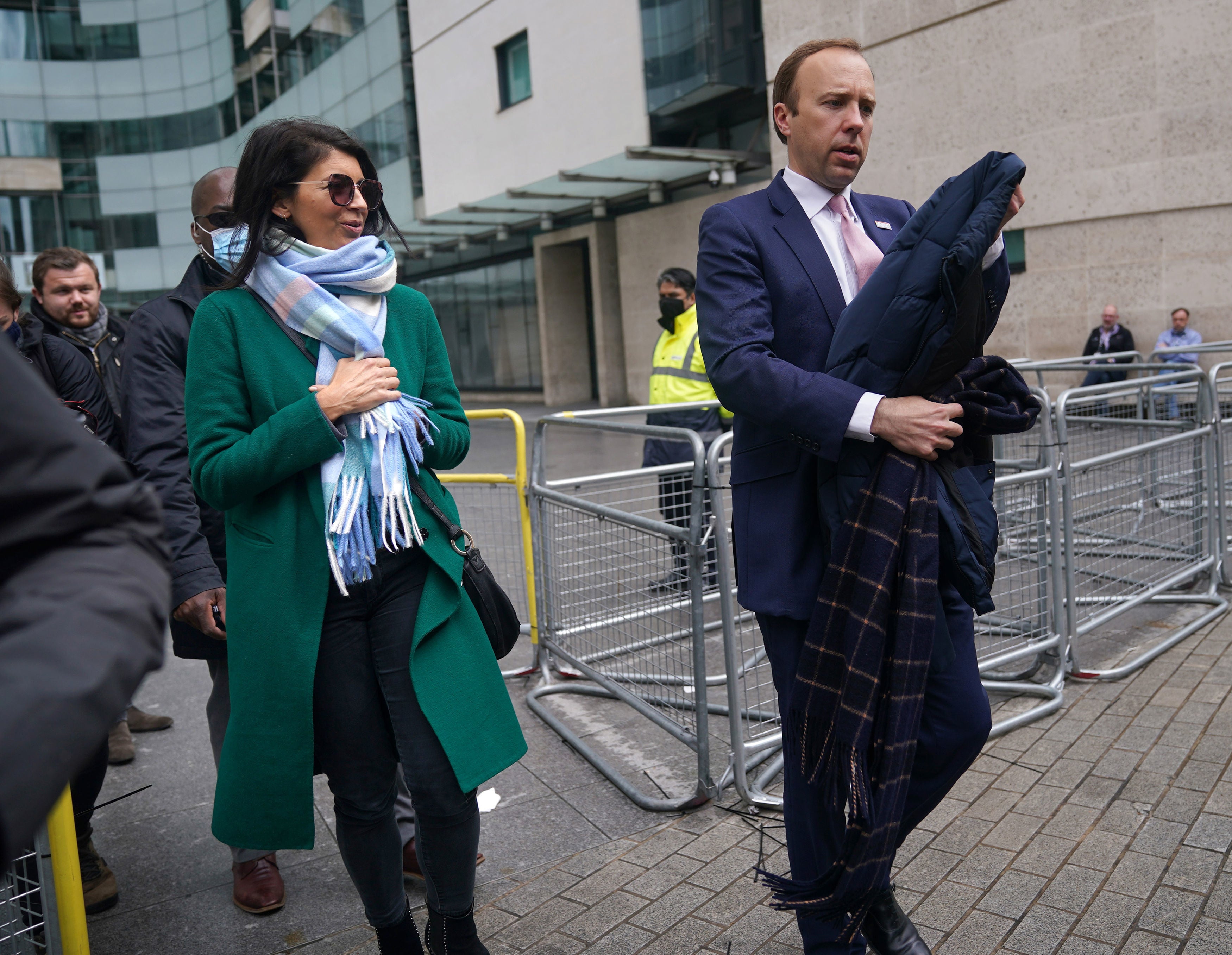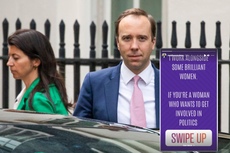Did Matt Hancock break the law? Experts point to grey area
Health secretary’s meeting with Gina Coladangelo would have to be ‘reasonably necessary for work purposes’ to be legal
The health secretary may have broken coronavirus laws that were imposed in his own name, experts have said.
Indoor meetings between people who did not live together or have a legal exemption were banned on the date that Matt Hancock was pictured kissing aide Gina Coladangelo.
The informally dubbed “sex ban” was in place for much of the pandemic under different versions of the Health Protection Regulations, which were created as statutory instruments in Mr Hancock’s name.
However, there were numerous exceptions to the law, including for gatherings that were “reasonably necessary for work purposes”.
Because Mr Hancock and Ms Coladangelo both work at the Department of Health, and images published by The Sun showed them inside its London headquarters, experts say the incident sits in a legal “grey area”.
Boris Johnson has supported the health secretary, who has apologised for breaking non-enforceable public health guidance.
At the time, members of the public were told not to hug loved ones.
In a statement, Mr Hancock said: “I accept that I breached the social distancing guidance in these circumstances, I have let people down and am very sorry.
”I remain focused on working to get the country out of this pandemic, and would be grateful for privacy for my family on this personal matter.“
What was the law?
At the time the images printed in The Sun were captured, England was under a set of laws officially named The Health Protection (Coronavirus, Restrictions) (Steps) (England) Regulations 2021.
Unlike previous versions of the regulations, which have been used to enforce lockdowns and localised restrictions throughout the pandemic, it created three “steps” of restrictions.
Step two came into force on 12 April 2021 and was still in effect when the images of Mr Hancock and Ms Coladangelo were taken on 6 May.
Although restrictions were eased to allow non-essential retail, gyms, hairdressers, pub gardens and outdoor dining to open, the law was still tight on gatherings.
It banned gatherings of two and more people indoors, unless they were subject to one of numerous exemptions.
One of those was gatherings that were “reasonably necessary for work purposes”.

So was Mr Hancock’s meeting with Ms Coladangelo legal?
Possibly. Adam Wagner, a human rights barrister with Doughty Street who has been closely following evolving coronavirus laws, said the incident was a “grey area”.
He said the question was not merely whether the pair were in the building for work purposes, but whether their interaction was “reasonably necessary” for work.
“There is an important question of whether the health secretary broke his own lockdown laws,” Mr Wagner said.
“Private indoor meetings between people not living together were unlawful for most of the past year … if they went elsewhere to meet up, that would clearly be illegal.”
What was the ‘sex ban’?
Coronavirus laws on gatherings have meant that indoor meetings between two people from different households, such as non-cohabiting couples and people on dates, have been illegal for much of the pandemic.
As they stood on 6 May, the Health Protection Regulations banned indoor gatherings “when two or more persons are present together in the same place in order to engage in any form of social interaction with each other, or to undertake any other activity with each other.”
There were however numerous exemptions, including when the gathering was “reasonably necessary for work”.
A separate provision previously made it illegal to stay overnight outside home “without reasonable excuse”, but that has been repealed.
At the start of the lockdown, government ministers and officials explicitly banned couples who did not live together from meeting.
After restrictions relaxed in September, Mr Hancock said that only “established” couples should be meeting for sex.
“I think we should stick to the letter of it, which is it is OK in an established relationship,” he added at the time.
“It just means that people need to be careful, they need to be sensible.
“If you’re in a relationship that is well established … what it means is people realising that coming into close contact with people from other households, then that is how the virus spreads.”

What is the punishment for breaking coronavirus laws?
The default punishment for breaking the Health Protection Regulations at the time was a £100 fine, which doubled for repeat offences to a maximum of £6,400.
Higher fines are available for more serious offences, including £10,000 for anyone found to have organised a large gathering and £1,000 for breaching restrictions on businesses.
There is no formal process for appealing fines and people who refuse to pay them can be prosecuted.
Police have the legal power to arrest people for breaking the law, but were instructed to detain people as a “last resort”.
Coronavirus fines are implemented through “fixed penalty notices”, which are normally given immediately when an officer detects an offence, rather than retrospectively.
The question of potential retrospective fines was raised following the furore over Dominic Cummings’s trip to Barnard Castle during the first national lockdown last year.
Durham Constabulary concluded that the former Downing Street adviser may have broken lockdown laws by driving to Barnard Castle in April 2020.
The police force said that if officers had stopped Mr Cummings during his journey, they would have spoken to him, ordered him to return home and taken “enforcement action” if he refused.
But they said there was “no intention to take retrospective action since this would amount to treating Mr Cummings differently from other members of the public”.
What about social distancing?
Social distancing has been a key part of the government’s public health guidance, and published on official websites throughout the pandemic.
However, it has never been incorporated into the Health Protection Regulations or other coronavirus laws that can be enforced by the police.
Government officials and ministers have been accused of causing confusion among both the public and police by continuing to create different law and guidance, and referring to them both as the “rules”.
Guidance has been stricter than the law for most of the pandemic, for example saying that people must only make “essential” journeys or exercise outside once a day, when the Health Protection Regulations did not impose those limits.
In April 2020, parliament’s Home Affairs Committee said: “Some of the challenges for the police have arisen due to the divergence between the regulations and the different statements from government.
“The Department for Health and Social Care and the Home Office need to ensure that where there is divergence between regulations and messages coming from central government they continue to provide swift clarity.”




Bookmark popover
Removed from bookmarks